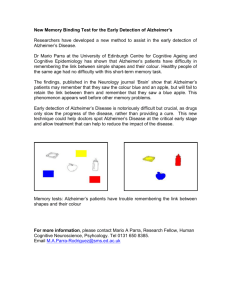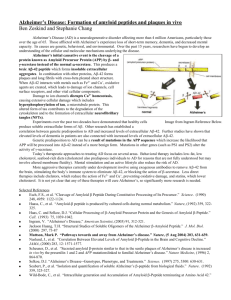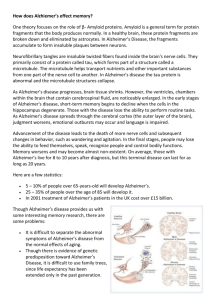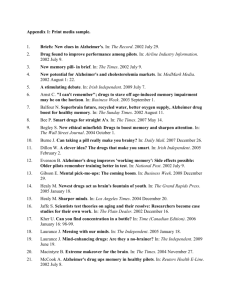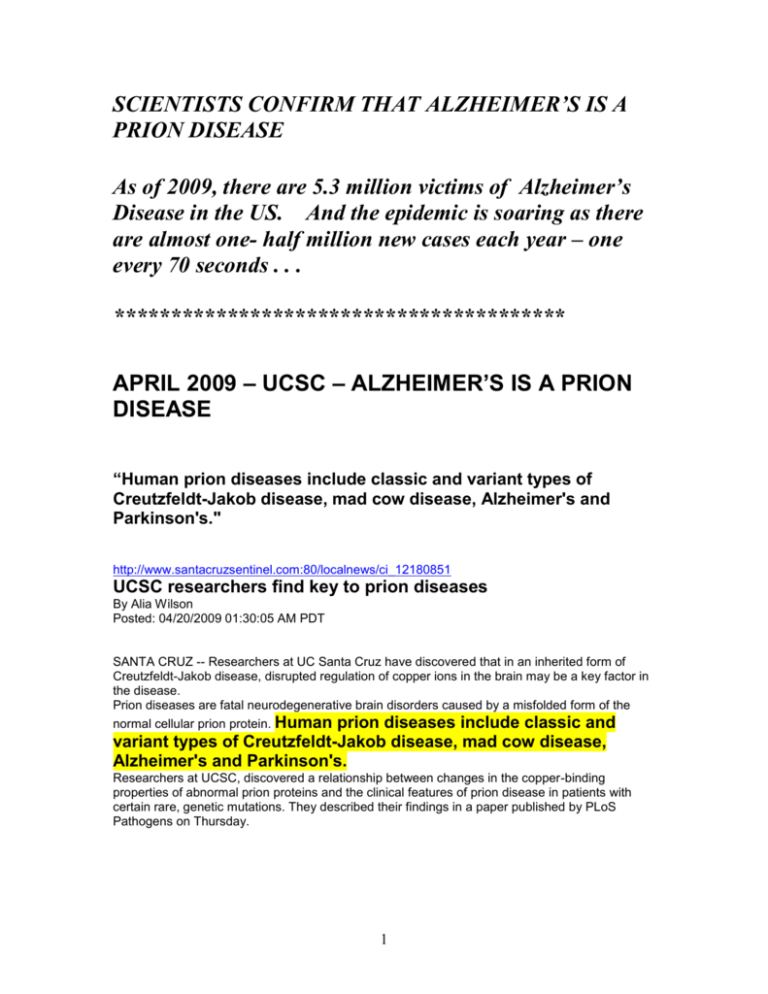
SCIENTISTS CONFIRM THAT ALZHEIMER’S IS A
PRION DISEASE
As of 2009, there are 5.3 million victims of Alzheimer’s
Disease in the US. And the epidemic is soaring as there
are almost one- half million new cases each year – one
every 70 seconds . . .
****************************************
APRIL 2009 – UCSC – ALZHEIMER’S IS A PRION
DISEASE
“Human prion diseases include classic and variant types of
Creutzfeldt-Jakob disease, mad cow disease, Alzheimer's and
Parkinson's."
http://www.santacruzsentinel.com:80/localnews/ci_12180851
UCSC researchers find key to prion diseases
By Alia Wilson
Posted: 04/20/2009 01:30:05 AM PDT
SANTA CRUZ -- Researchers at UC Santa Cruz have discovered that in an inherited form of
Creutzfeldt-Jakob disease, disrupted regulation of copper ions in the brain may be a key factor in
the disease.
Prion diseases are fatal neurodegenerative brain disorders caused by a misfolded form of the
normal cellular prion protein. Human prion diseases include classic and
variant types of Creutzfeldt-Jakob disease, mad cow disease,
Alzheimer's and Parkinson's.
Researchers at UCSC, discovered a relationship between changes in the copper-binding
properties of abnormal prion proteins and the clinical features of prion disease in patients with
certain rare, genetic mutations. They described their findings in a paper published by PLoS
Pathogens on Thursday.
1
"The loss of copper regulation may play a very important role in prion disease
progression," said Glenn Millhauser, professor of chemistry and biochemistry at
UCSC and corresponding author of the paper.
********************************************
28 year old man with iCJD and Alzheimer’s – 23 year
incubation
http://jnnp.bmj.com/content/77/3/413.abstract
J Neurol Neurosurg Psychiatry 2006;77:413-416 doi:10.1136/jnnp.2005.070805
Short report
Alzheimer-type neuropathology in a 28 year old patient with iatrogenic Creutzfeldt-Jakob
disease after dural grafting
M Preusser1,
T Ströbel1,
E Gelpi1,2,
M Eiler3,
G Broessner4,
E Schmutzhard4,
H Budka1,2
+ Author Affiliations
1
Institute of Neurology, Medical University Vienna, Austria
2
Austrian Reference Centre for Human Prion Diseases (OERPE), General Hospital
Vienna, Austria
3
Department of Neurology, LKH Rankweil, Austria
4
Department of Neurology, Medical University Innsbruck, Innsbruck, Austria
Correspondence to:
Dr H Budka
Institute of Neurology, Medical University of
Vienna, Waehringer Guertel 18-20, 4J, 1097 Vienna, Austria; herbert.budka@kin.at
Received 27 April 2005
Accepted 9 August 2005
Revised 24 June 2005
Abstract
We report the case of a 28 year old man who had received a cadaverous dura mater graft
after a traumatic open skull fracture with tearing of the dura at the age of 5 years.
2
A clinical suspicion of Creutzfeldt-Jakob disease (CJD) was confirmed by a brain biopsy
5 months prior to death and by autopsy, thus warranting the diagnosis of iatrogenic CJD
(iCJD) according to WHO criteria. Immunohistochemistry showed widespread cortical
depositions of disease associated prion protein (PrPsc) in a synaptic pattern, and western
blot analysis identified PrPsc of type 2A according to Parchi et al.
Surprisingly, we found Alzheimer-type senile plaques and cerebral
amyloid angiopathy in widespread areas of the brain. Plaque-type and
vascular amyloid was immunohistochemically identified as deposits of
beta-A4 peptide. CERAD criteria for diagnosis of definite Alzheimer’s
disease (AD) were met in the absence of neurofibrillar tangles or alphasynuclein immunoreactive inclusions. There was no family history of
AD, CJD, or any other neurological disease, and genetic analysis
showed no disease specific mutations of the prion protein, presenilin 1
and 2, or amyloid precursor protein genes.
This case represents (a) the iCJD case with the longest incubation time
after dural grafting reported so far, (b) the youngest
documented patient with concomitant CJD and
Alzheimer-type neuropathology to date, (c) the first
description of Alzheimer-type changes in iCJD, and (d) the
second case of iCJD in Austria. Despite the young patient age, the
Alzheimer-type changes may be an incidental finding, possibly related
to the childhood trauma
*************************************************************
****************************************************************
http://www.sciencemag.org/cgi/content/short/326/5958/1337
Science 4 December 2009:
Vol. 326. no. 5958, pp. 1337 - 1339
DOI: 10.1126/science.326.5958.1337
3
News Focus
Neurodegeneration:
Could They All Be Prion Diseases?
Greg Miller
Misfolded proteins called prions are the cause of several neurodegenerative
disorders in humans and other animals. A recent flurry of papers has revived
interest in the idea that such mechanisms may play a role in an even wider range of
neurodegenerative disorders, including two of the most dreaded scourges of old age:
Alzheimer's and Parkinson's diseases.
Such diseases almost certainly aren't contagious like true prion diseases are, at least in
ordinary circumstances, but they may propagate through the nervous system in much
the same way. Evidence from recent animal studies suggests that many of the
misfolded proteins thought to play a central role in a wide range of
neurodegenerative disorders can, like prions, "seed" the misfolding and aggregation
of their normally folded kin. In some cases, these pathological protein clusters
appear to propagate from cell to cell. Such a mechanism could help explain several
puzzles—such as why some neurodegenerative disorders tend to spread from one
part of the nervous system to another in a characteristic pattern, and why some
researchers have found pathological protein deposits in fetal stem cells transplanted
into the brains of Parkinson's patients.
***********************************************************
http://emedicine.medscape.com/article/1168941-overview
Prion-Related Diseases
Author: Tarakad S Ramachandran, MBBS, FRCP(C), FACP, Professor of
Neurology, Clinical Professor of Medicine, Clinical Professor of Family
Medicine, Clinical Professor of Neurosurgery, State University of New York
Upstate Medical University; Chair, Department of Neurology, Crouse Irving
Memorial Hospital
Coauthor(s): Arun Ramachandran, State University of New York Upstate
Medical University
Contributor Information and Disclosures
Updated: Sep 21, 2009
4
Background
The prion diseases are a large group of related neurodegenerative conditions, which affect both
animals and humans.1 Included are Creutzfeldt-Jakob disease (CJD) and Gerstmann-StrãusslerScheinker (GSS) in humans, bovine spongiform encephalopathy (BSE, or "mad cow disease") in
cattle, chronic wasting disease (CWD) in mule deer and elk, and scrapie in sheep. These diseases all
have long incubation periods but are typically rapidly progressive once clinical symptoms begin. All
prion diseases are fatal, with no effective form of treatment currently; however, increased
understanding of their pathogenesis has recently led to the promise of effective therapeutic
interventions in the near future. . . .
“Prion diseases are unique in that they can be inherited, they can occur sporadically, or they can be
infectious. The infectious agent in the prion disease is composed mainly or entirely of an abnormal
conformation of a host-encoded glycoprotein called the prion protein. The replication of prions involves
the recruitment of the normally expressed prion protein, which has mainly an alpha-helical structure,
into a disease-specific conformation that is rich in beta-sheet. . . . snip . . .
o
“The
prominent involvement of the brainstem often
leads to symptoms suggestive of
olivopontocerebellar degeneration. The pattern of
inheritance is autosomal dominant and is caused by
mutations of the PrP gene. The neuropathology of
GSS is remarkable in that extensive and invariable
amyloid deposition occurs, in addition to the typical
spongiform change, gliosis, and neuronal loss.
o
o
Interestingly, in several kindreds of GSS, extensive
neurofibrillary tangle (NFT) formation is found.53 NFTs
are an essential feature of Alzheimer disease, but are
also observed in other neurodegenerative conditions.
o
o
Another variation of autosomal dominantly inherited
human prionosis has been termed prion protein
congophilic angiopathy (ie, prion protein cerebral
amyloid angiopathy [PrP-CAA]), which is
characterized by cerebral vessel amyloid deposition
and the presence of NFT.54 Cerebral amyloid
angiopathy (CAA) is also an essential feature of
Alzheimer disease. Both these variants of prionoses
5
further link the pathogenesis of Alzheimer disease
and the prion-related diseases.”
**********************************************************************************************
25th Feb 2009
ALZHEIMER'S - PRION CAUSES AMYLOID PLAQUE BUILD UP JOURNAL - NATURE
J. Lauren et al (2009) Nature vol 457, p 1128 to 1132
http://www.thenakedscientists.com/HTML/content/news/news/1635/
Alzheimer’s prion protein clue
More than 20 million people around the world are affected by Alzheimer’s disease, a
the
effects of the disease are due to the buildup of a protein
called amyloid-beta, which makes lumps, called plaques, in
the brain.
degenerative brain condition that is currently incurable. We know that many of
But until now it hasn’t been clear exactly how amyloid protein starts to build up in
this week, scientists in the
US have discovered that the buildup of amyloid might
be aided by a rogue protein – the prion protein cells in the
brain cells, or the root cause of the illness. But
brain and helping to grow new neurons. But sometimes PrP is found in a different
shape, or conformation, and this is where the trouble starts, as it causes severe
problems in the brain. It’s high levels of the bad form of PrP that lead to CJD
The prion protein, PrP, is found in many different cells and sits in the membrane that
surrounds cells. Normally, it does a useful job helping brain cells to respond to changes
in the environment around them, as well as controlling the immune.
Writing in this week’s edition of the journal Nature, the researchers
discovered that amyloid-beta can stick to the normal form of the prion
6
protein, and this might be what causes amyloid to build up in brain
cells. Importantly, they discovered that little groups of amyloid are
more likely to stick to the prion protein than single amyloid molecules,
suggesting that it’s important for building up amyloid plaques, and
could be a key step in Alzheimer’s.
The scientists went on to look at samples of mouse brains, particularly
looking at the hippocampus – the part of the brain that’s involved in
learning and memory, which is badly affected in Alzheimer’s. They found
that in brain samples from normal mice, the buildup of amyloid protein blocked a process
called long term potentiation – which is basically how the brain builds memory. But in
samples from mice that lacked the prion protein, amyloid didn’t cause problems with
long term potentiation. So this shows that the prion protein is a key link in
the chain.
This discovery is pretty exciting because it gives us a new angle for Alzheimer’s
treatments. Perhaps if researchers could develop drugs that block the interaction
between amyloid and the prion protein, this might be potential way to prevent the
plaques building up, or reduce their effects on the brain.
But there’s a lot we don’t know. For example, we don’t know if the prion protein changes
shape once it has stuck to amyloid – does it stay in the normal conformation, or change to
the bad version? And it’s clear that the prion protein isn’t the whole story, because if you
get rid of the prion proteins altogether, you only reduce the binding of amyloid to brain
cells by about 50%. But it’s certainly a good start, and an exciting new lead for future
research.
References
- J. Lauren et al (2009) Nature vol 457, p 1128 to 1132
http://www.lifeinitaly.com/node/16574
PROTEIN ROLE IN ALZHEIMER'S
NEW ITALIAN STUDY CONFIRMS PROTEIN ROLE IN
ALZHEIMER'S
7
(ANSA) - Rome, January 14, 2010 - A team of Italian scientists has confirmed the
critical role played by a group of amino acids in the brains of Alzheimer's disease
patients, according to a new study.
The research looked at the impact of amyloid beta amino acid chains, thought to be the
main component responsible for plaque build-ups in the brain of those suffering from the
disease.
Although scientists have long known of the role these amino acids play in
Alzheimer's, the research by the Mario Negri Istitute of Milan explored
the link between beta amyloid proteins and prion proteins, which cause
mad cow disease (BSE) and its human variant Creutzfeldt-Jakob disease
(CDJ).
The team first applied small soluble aggregates of the beta amyloid protein, similar to
those found in Alzheimer's patients onto the brain of laboratory animals.
The application of these aggregates, known as oligomers, was found to cause selective
memory loss among the animals, the report authors noted.
*********************************************************
http://scienceblogs.com/notrocketscience/2009/02/fishing_expedition_reveals_unexpected_link_b
etween_alzheimer.php
Fishing expedition reveals unexpected link
between Alzheimer's and prion diseases
Category: Brain • Medicine & health • Mental Health • Neuroscience
Posted on: February 25, 2009 1:00 PM, by Ed Yong
Alzheimer's disease is the most common form of dementia in the world, affecting more than 26
million people. Creutzfeld-Jacob disease (CJD), another affliction is far less common, but both
conditions share many of the same qualities. They are fatal within a few years of diagnosis, they
Now, a
group of Yale researchers have discovered that the two diseases
are also linked by a pair of critical proteins.
are incurable and they involved the crippling degeneration of the brain's neurons.
Look into the brain of someone with Alzheimer's disease and you will see large,
insoluble "plaques" sitting between nerve cells. They consist of a protein
fragment (or "peptide") called amyloid-beta, accumulating in its thousands. These
plaques are a hallmark of the disease, but even before they have formed,
amyloid-beta peptides have already begun to cluster in small soluble groups.
Even at this stage, they can impair memory, degrading the connections between
separate neurons.
8
Juha Lauren wanted to work out how exactly clusters of amyloid-beta wreak havoc in neurons
before they form plaques. In particular, he was after the identity of its molecular accomplices.
Many proteins work their will in a cell by attaching to other proteins called receptors. To see if
amyloid-beta does the same, Lauren's team went fishing for receptors.
They created a synthetic version of the amyloid-beta peptide and connected it to a molecule
called biotin - these were their hooks. Lauren lowered them into a massive pool of different
proteins found in the brains of mice; if one of those was a receptor for amyloid-beta, it should take
the bait and stick to it. As a rod, he used beads covered in a molecule called avidin, which sticks
very strongly to biotin. The beads attracted biotin, which was stuck to amyloid-beta, which was in
turn bound to its receptor.
From hundreds of thousands of proteins, their fishing trips
pulled out just one that stuck to amyloid-beta, and it's a familiar
one - the prion protein. Incorrectly folded versions of this
protein (PrPSC) are the culprits behind diseases like CJD, mad
cow disease and scrapie. And now it seems that the normal,
correctly folded version (PrPC) plays a role in Alzheimer's
disease too, by acting as the receptor for amyloid-beta. It's the
accomplice through which amyloid-beta clusters work their
damaging effects on neurons.
*****************************************************************************
Adriano Aguzzi Stephen Strittmatter
http://www.sciencenews.org/view/generic/id/41188/title/Prions_complicit_in_Alzheimer%E2%80%
99s_disease#comment_editor
Prions complicit in Alzheimer’s disease
Supposedly harmless version plays a role in
neuron malfunction
By Laura Sanders
March 28th, 2009; Vol.175 #7 (p. 10)
Size
Prion protein, notorious for causing the brainwasting mad cow and Creutzfeldt-Jakob diseases,
may also be a coconspirator in Alzheimer’s
disease, a new study in mice suggests.
9
In mad cow and Creutzfeldt-Jakob diseases, misshapen prion proteins do the damage. But
the new paper, appearing February 26 in Nature, offers evidence that the
harmless version of the prion protein assists the amyloid-beta
protein responsible for brain cell death in Alzheimer’s disease.
“It’s pretty sensational,” comments Adriano Aguzzi, a
neuropathologist at the University of Zurich. “What’s
tremendously electrifying is that prion protein may be a genetic
sensor for extremely toxic, small concentrations of A-beta.”
A-beta proteins can travel alone or in groups in the brain. On their own, A-beta proteins are
harmless. Massive, insoluble clumps of A-beta, known as plaques, are probably harmless,
too, says study coauthor Stephen Strittmatter, a neuroscientist at
Yale University. These plaques may be a gravestone marker of dead brain cells but
are probably not the killer. Instead, smaller, soluble clumps of 50 to 100 Abeta proteins, known as oligomers, are the most likely suspect,
Strittmatter says.
Earlier studies have shown that mice with A-beta oligomers can’t remember how to get
through a maze as quickly as mice without A-beta oligomers. Such oligomers
prevent cross-talk between certain brain cells in the hippocampus
of mice, which helps explain the loss of learning and memory
functions in Alzheimer’s disease.
**************************************************************
http://mednews.wustl.edu/news/page/normal/15213.html
Family's inherited condition links prion diseases, Alzheimer's
By Michael Purdy
Dec. 8, 2009 -- A laboratory connection between Alzheimer's
disease and brain-wasting diseases such as the human form of
mad cow disease has moved into the clinic for what is believed
to be the first time, manifesting itself in the brains of patients
with a rare inherited disorder.
In three cases from an Illinois family, researchers at Washington
University School of Medicine in St. Louis report that brain
10
regions harmed by an inherited form of Creutzfeldt-Jakob
disease (CJD) also have amyloid plaques identical to those
found in the same brain areas in Alzheimer's patients.
The finding adds to other, earlier evidence suggesting that the misfolded
protein believed to cause CJD, known as a prion, appears to play a role in
the Alzheimer's disease process.
"This interplay between amyloid and the prion protein raises
questions about whether these diseases are really all that
different, and whether there are common pathways involved in
both conditions that can provide an avenue for new treatments,"
says lead author Nupur Ghoshal, M.D., Ph.D., an investigator at
Washington University's Alzheimer's Disease Research Center
(ADRC).
Ghoshal's research, published in Archives of Neurology, began with the autopsy of a patient who
died from inherited CJD more than two decades ago after being followed clinically by senior
author John C. Morris, M.D., now the Harvey A. and Dorismae Hacker Friedman Distinguished
Professor of Neurology and director of the ADRC. The autopsy revealed not only the expected
brain changes inflicted by CJD but also amyloid brain plaques, even though the patient was
younger than the age at which Alzheimer's typically occurs.
CJD and other spongiform encephalopathies rapidly plunge patients into dementia, causing death
in a few months to years. They have been associated with rare genetic mutations typically found
in a handful of ethnic groups that includes some Jewish sects and some Eastern European
lineages. In recent decades, sporadic cases of CJD-like diseases have been associated with
consumption of brain and spinal tissues from cows with a brain-wasting condition called mad cow
disease. These cases helped spur development of a theory that a misfolded protein known as a
prion causes inherited and transmissible forms of diseases like CJD.
Healthy organisms normally make the prion protein, which in its regular configuration contributes
in a yet-to-be-identified way to the function of nerve cells. Researchers believe misfolded copies
of the prion protein can cause other nearby copies of the protein to misfold, triggering a harmful
chain reaction that leads to conditions like CJD.
Ghoshal's analysis showed that the amyloid detected in the
initial CJD patient's autopsy was the same type found in the
brains of patients with Alzheimer's. The amyloid appeared in
regions of the brain most often harmed by CJD and Alzheimer's
disease.
******************************************************************
11
http://blog.bioasis.ca/?p=2361
Bioasis Technologies Inc.
The Science of Melanotransferrin (p97)
The Relationship Between Alzheimer’s, Parkinson’s, and Huntington’s
Disease
by Henry on December 10, 2009
“We have discovered a compelling new therapeutic approach for Parkinson’s disease, which we
expect will allow our scientists – as well as those at pharmaceutical and biotech companies – to
pursue innovative new drugs that will treat and perhaps even cure this disorder,” says Aleksey
Kazantsev, PhD, director of MGH-MIND Drug Discovery Laboratory, who led the Science study.
“Since the same sort of aggregation of misfolded proteins has
been reported in Huntington’s and Alzheimer’s diseases – as
well as Lewy body dementia, which also involves alphasynuclein deposits – we plan to test this approach in those conditions
as well.”
From: Dorothy Kraemer
To: cjdnews@yahoogroups.com
Sent: Saturday, April 04, 2009 10:43 AM
Subject: [CJDNEWS] Fw: [CJDVoice] Under-reported Dementia Deaths Raises Questions About
Accuracy Of Mortality Statistics
This under-reporting on death certificates is not just a problem with CJD patients. I can't
believe these numbers!
http://www.sciencedaily.com/releases/2008/12/081210171914.htm
12
Under-reported Dementia Deaths Raises Questions
About Accuracy Of Mortality Statistics
ScienceDaily (Dec. 16, 2008) — Deaths due to dementia and Alzheimer's disease are
underreported on death certificates, according to a study conducted by Hebrew
SeniorLife's Institute for Aging Research (IFAR), raising concerns about the
accuracy of mortality statistics based on these documents.
According to the National Center for Health Statistics (NCHS), which derives its data
from death certificates, Alzheimer's disease, the most common form of dementia, is
the fifth leading cause of death among Americans over age 65. Dementia is the loss of
mental capacities—thinking, memory, reasoning and decision making, among others—
that interferes with a person's daily functioning
http://www.sfgate.com/cgi-bin/article.cgi?f=/c/a/2009/02/25/MNC7164VHL.DTL
February 2009
The latest in a recent flurry of clues on the workings of Alzheimer's
disease comes from Yale University researchers who found a link
between the disorder and the prion protein, which can cause mad cow
disease and other maladies.
The Yale team found that the prion protein, whose normal function is to
maintain brain health, may contribute to nerve damage if it becomes
entangled with a protein fragment that scientists consider a chief suspect
as a cause for Alzheimer's disease.
That suspect fragment, the amyloid beta peptide, builds up in the gluey
plaques in the brain that are a characteristic sign of Alzheimer's, a
progressive neurodegenerative disease. The amyloid peptide seems to stick to
the prion protein, block its benign effects and interfere with learning and
memory, the Yale group said in a paper published today in the journal
Nature.
****************************************************************
13
Published online first JULY 22, 2008
Free Abstract
Article (References)
Article (PDF 280 KB)
Original Paper
Association between Deposition of Beta-Amyloid and Pathological Prion Protein in
Sporadic Creutzfeldt-Jakob Disease
Laura Debatina, Johannes Strefferb, Markus Geissenc, Jakob Matschkec, Adriano Aguzzia,
Markus Glatzela, c
a
Institute of Neuropathology, and
Division of Psychiatry Research, University Hospital Zurich, Zurich, Switzerland;
c
Institute of Neuropathology, University Medical Center Hamburg-Eppendorf, Hamburg,
Germany
b
Address of Corresponding Author
Neurodegenerative Dis (DOI: 10.1159/000121389)
Key Words
Sporadic Creutzfeldt-Jakob disease
Alzheimer's disease
Deposition of -amyloid
Prion protein
Abstract
Background: Alzheimer's disease (AD) and prion diseases such as
sporadic Creutzfeldt-Jakob disease (sCJD) share common features
concerning their molecular pathogenesis and neuropathological
presentation and the coexistence of AD and CJD in patients suggest an
association between the deposition of the proteolytically processed form
of the amyloid precursor protein, -amyloid (A ), which deposits in AD,
and the abnormal form of the prion protein, PrPSc, which deposits in
sCJD.
14
Methods:
We have characterized sCJD patients (n = 14), AD patients (n = 5) and nondemented
controls (n = 5) with respect to the deposition of PrPSc and A morphologically,
biochemically and genetically and correlated these findings to clinical data.
Results: sCJD-diseased individuals with abundant deposits of A present with a specific
clinicopathological profile, defined by higher age at disease onset, long disease duration,
a genetic profile and only minimal amounts of PrPSc in the cerebellum.
Conclusion: The co-occurrence of pathological changes typical for sCJD
and AD in combination with the inverse association between
accumulation of A and PrPSc in a subgroup of sCJD patients is
indicative of common pathways involved in the generation or clearance
of A and PrPSc in a subgroup of sCJD patients.
Copyright © 2008 S. Karger AG, Basel
******************************************************************************
http://www.nih.gov/news/research_matters/march2009/03092009alzheimers.htm
March 9, 2009
Non-Infectious Prion Protein Linked to Alzheimer’s Disease
The prion protein, notorious for causing fatal neurodegenerative
disorders such as Creutzfeldt-Jakob disease and mad cow disease, may
also be an accomplice in Alzheimer’s disease, according to a new study.
In this case, it’s not the infectious misfolded prion protein causing the
problem but the cellular form, whose function is relatively unknown.
A region of amyloid plaque in the brain of a person with Alzheimer's disease. Image
courtesy of Medical Microscopy Sciences, Cardiff University School of Medicine. All
rights reserved by Wellcome Images.
Alzheimer’s disease is marked by clumps of protein fibers called amyloids that
accumulate into “plaques” around nerve cells in the brain, leading to the progressive loss
of function. The main protein fragment found in these plaques, amyloid-ß peptide, is
created by the improper cleavage of a protein called amyloid precursor protein (APP).
Over time, amyloid-ß peptides transform into small clusters known as oligomers,
which then develop into the long, sticky fibers that form plaques around brain cells.
Scientists are uncertain if amyloid-ß oligomers act directly or through cell surface
15
receptors to affect thinking and decision-making, but most agree that they’re toxic
to brain.
A team of scientists led by Dr. Stephen Strittmatter at Yale University reasoned that if
there were cell surface receptors on brain cells that bound amyloid-ß oligomers, they
might play a role in altering nerve cell function. Their search for these proteins was
supported by NIH’s National Institute of Neurological Disorders and Stroke (NINDS),
National Institute of Drug Abuse (NIDA) and the NIH Medical Scientist Training
Program.
Huntington disease phenocopy is a familial prion disease.
Huntington disease phenocopy is a familial prion disease. Moore
RC, Xiang F, Monaghan J, Han D, Zhang Z, Edström L, Anvret
M, Prusiner SB. ...
www.ncbi.nlm.nih.gov/pubmed/11593450 ********************************************************************
More than 5 million have Alzheimer's in U.S. - Alzheimer's Disease ...
updated 6:15 p.m. ET March 18, 2008. WASHINGTON - An estimated 5.2 million
Americans have Alzheimer’s disease, and it could steal the minds of one out of ...
www.msnbc.msn.com/id/23697160/ - 49k - Cached - Similar pages - Note this
– Canada
THE RELATIONSHIP BETWEEN THE ALZHEIMERS EPIDEMIC
AND CJD ??
http://www.thebukowskiagency.com/DyingForAHamburger.htm
Absolutely impossible, insisted British health authorities, that mad
cow disease could be transmitted to humans through infected beef.
Yet less than a decade later, hundreds of people (including recent
victims in Saskatchewan and Florida) who ate infected beef have
died of Creutzfeldt-Jakob disease (CJD), with perhaps hundreds of
thousands more at risk for developing the disease. Could the same
scenario hold true for Alzheimer’s disease?
Before about 1900 Alzheimer’s disease did not exist, or if it did, was
16
so rare as not to be noticed. We know that as long as people have
been keeping records, they have inventoried diseases. But just over
a hundred years ago, Alzheimer’s disease was unknown, and most
people did not know anyone who exhibited the symptoms of dementia
that are now all too familiar to the families and friends of victims.
Alzheimer’s disease (AD) now afflicts 15 million people around
the world, including 250,000 Canadians and 4.5 million
Americans. One in 10 persons over 65 and nearly half of those
over 85 have the disease. More significantly, the number of
people with dementia is expected to increase steadily over the
next 25 years: in Canada, 10,000 new cases of AD are diagnosed
each year – 27 cases per day.
Dying for a Hamburger presents strong evidence that Alzheimer’s
disease is caused by the same agent that causes mad cow disease
(bovine spongiform encephalopathy, or BSE), variant CreutzfeldtJakob disease (vCJD), and a host of other neurodegenerative
diseases called transmissible spongiform encephalopathies (TSEs).
Dying For a Hamburger now presents compelling evidence that
Alzheimer’s disease has become epidemic due to
modern meat-packing practices.
The link between eating processed meat and Alzheimer’s
disease unfolds as a remarkable narrative, one of the most
fascinating stories in modern medicine. The tale involves
cannibals, both two- and four-legged, one Nobel Prize winner who is
a convicted paedophile, and another who is reputed to be one of the
most disliked men in academic medicine.
Dying for a Hamburger is a medical story, a detective story, a
story of bureaucratic bungling, and a story of the rise of an
epidemic that has already created extraordinary public health,
social, and economic implications. With baby boomers fast
heading towards their sixth decade, our society will soon
experience far-reaching consequences of the AD epidemic – in
the work force, government, health care, medicine, business,
and industry – in the next twenty years. This is a story that
affects all of us.
17
http://www.sciencecodex.com/brain_plaques_in_healthy_individuals_linked_to_increased_alzhei
mers_risk
Brain plaques in healthy individuals linked to
increased Alzheimer's risk
Posted On: December 14, 2009 - 9:30pm
St. Louis, Dec. 10, 2009 — Scientists have long assumed that amyloid
brain plaques found in autopsies of Alzheimer's patients are harmful
and cause Alzheimer's disease. But autopsies of people with no signs of
mental impairment have also revealed brain plaques, challenging this
theory.
Now, for the first time, researchers at Washington University in St.
Louis have shown that brain plaques in apparently healthy individuals
are associated with increased risk of diagnosis with Alzheimer's disease
years later.
In two studies published this month in Archives of Neurology, scientists report that
volunteers with brain plaques were more likely to have declining scores on annual
cognitive tests, to show signs of shrinkage in a key brain area affected by Alzheimer's
and to eventually be diagnosed with the disease
.
"We don't have enough data yet to definitively say that people who scan positive for
these brain plaques have presymptomatic Alzheimer's disease, but something is
clearly going on that does not bode well for the health of their aging brains," says
John C. Morris, the Harvey A. and Dorismae Hacker Friedman Distinguished Professor
of Neurology and director of Washington University's Alzheimer's Disease Research
Center (ADRC) and the Friedman Center for Aging.
Morris and others at the ADRC have previously found evidence that Alzheimer's disease
harms the brain for years prior to typical diagnosis. They are pushing for earlier diagnosis
as an essential step to successful treatment of Alzheimer's disease, but to do that they first
have to seek earlier indicators of disease and then wait years to see if people with the
indicators later develop symptomatic Alzheimer's.
According to Morris, the new papers are early and encouraging indicators that scientists
are on track to pushing back the time at which diagnosis can be made.
18
"We only have a very small number of subjects to date, but what we're learning so far has
been consistent with our predictions," he says.
The new studies were made possible by the development of an imaging agent,
Pittsburgh Compound B (PiB), that lets scientists use positron emission tomography
scans to detect amyloid plaques in living brains for the first time. Prior to PiB,
clinicians could only verify the presence of brain plaques during autopsies. PiB scanning
of ADRC research participants is directed by Mark Mintun, M.D., vice chair for research
in radiology and professor of radiology at the University's Mallinckrodt Institute of
Radiology.
Martha Storandt, Ph.D., professor of psychology and of neurology, led one of the studies,
which compared a variety of factors in plaque-positive and plaque-negative subjects.
"One of the main things we wanted to know was whether people who scanned positive
for brain plaques scored abnormally low on cognitive tests," she says. "They didn't, but
when we looked at their annual testing records over a period of years, we saw that the
scores of the plaque-positive group were declining, while those of the plaque-negative
group were not."
*******************************************************
http://www.alzheimersanddementia.org/webfiles/images/journals/jalz/JALZ_739.pdf
Saturday, March 22, 2008
10 Million Baby Boomers to have Alzheimer's in the coming decades
2008 Alzheimer’s disease facts and figures
Alzheimer’s Association*
Abstract Alzheimer’s disease is the seventh leading cause of all deaths in the
United States and the fifth leading cause of death in Americans older than
the age of 65 years. More than 5 million Americans are estimated to have
Alzheimer’s disease. Every 71 seconds someone in America develops
Alzheimer’s disease; by 2050 it is expected to occur every 33 seconds.
During the coming decades, baby boomers are projected to add 10 million people
to these numbers.
DR. JOEL PEDERSEN, ET AL, UNIV. OF WISCONSIN – PRIONS IN
SEWAGE SLUDGE:
http://pubs.acs.org/doi/abs/10.1021/es703186e
19
Here, we report the results of experiments examining the partitioning and persistence of PrPTSE
during simulated wastewater treatment processes including activated and mesophilic anaerobic
sludge digestion. Incubation
TSE
with activated sludge did not result
in significant PrP degradation. PrPTSE and prion
infectivity partitioned strongly to activated sludge solids
and are expected to enter biosolids treatment processes.
Note: Prions have been found in the muscles, blood, urine
and feces of human and animal victims of prion diseases.
DR. MURRAY WALDMAN, TORONTO MEDICAL EXAMINER, DYING FOR
HAMBURGERS ALZHEIMERS EPIDEMIC
http://www.canada.com/calgary/calgaryherald/news/story.html?id=73024452-8ee6-477b-8e60d96c145abe72
Ranchers, scientists air beef over book
Jim Farrell
CanWest News Service
Sunday, April 11, 2004
A major Canadian publisher is likely to add to the woes of the beef industry by releasing
a book that blames hamburgers for an "epidemic of Alzheimer's disease."
Dr. Murray Waldman, a coroner with the City of Toronto and co-author of the
McClelland and Stewart book, Dying for a Hamburger: modern meat processing and the
epidemic of Alzheimer's disease, charges hamburger is the main source of prions, which
trigger Alzheimer's.
Prions, a type of malformed protein found in the brains of infected animals and humans,
are credited as the cause of mad cow disease, several cases of which have been linked to
Canadian cattle, and its human form, variant Creutzfeldt-Jakob disease.
The book is slated for release in the next two weeks.
But Canada's leading expert on prions said Waldman doesn't know what he is talking
about. Alzheimer's isn't a prion disease, said Dr. David Westaway of the University of
Toronto; experiments have shown it isn't transmissible.
20
An epidemiologist whose studies are quoted in the book says Waldman and co-author
Marjorie Lamb misinterpreted his findings.
"There's no evidence of Alzheimer's being a prion-caused disease," said epidemiologist
Dr. Hugh Hendrie of the University of Indiana. "Pathologically, Alzheimer's and variant
Creutzfeldt-Jakob disease don't look the same at all."
The executive vice-president of the Canadian Cattleman's Association has heard of
Waldman's theory and knows about his forthcoming book. Dennis Laycraft hopes readers
and beef consumers will dismiss Waldman's theory.
"There are a lot of theories out there but we have to trust in the intelligence of the reading
public," Laycraft said.
Reached by phone Saturday, Waldman insisted his science is strong. There is no
contradiction between what is in his book and what Westaway says, Waldman claimed.
"I never said that Alzheimer's is transmissible or that it is a prion disease.
What I am saying is that Alzheimer's is caused by prions, that prions set in
motion a chain of events and there are some fairly good articles to prove
that."
It is only the prions, not Alzheimer's that are transmissible, Waldman said.
Those prions merely set the stage for non-transmissible Alzheimer's
In its 270 pages, Dying for a Hamburger surveys the history of dementia from the ancient
to the modern world, cannibalism in New Guinea, Europe's mad cow disaster, the nature
of prions, the beef-rich diets of North Americans, the beef-restricted diets of people in
West Africa, the meatless diets of India and modern meat-packing practices. Waldman
argues that because processed meat and hamburger from many cows can end up in a
single package, a single prion-infected cow among millions of slaughtered cows can
infect multiple humans.
A century ago, that couldn't happen because meat from a single animal was kept separate
from the meat of other animals. Cows also weren't fed protein additives made from the
remains of other cows, so prion diseases weren't transmitted from one cow to another.
© The Calgary Herald 2004
21


